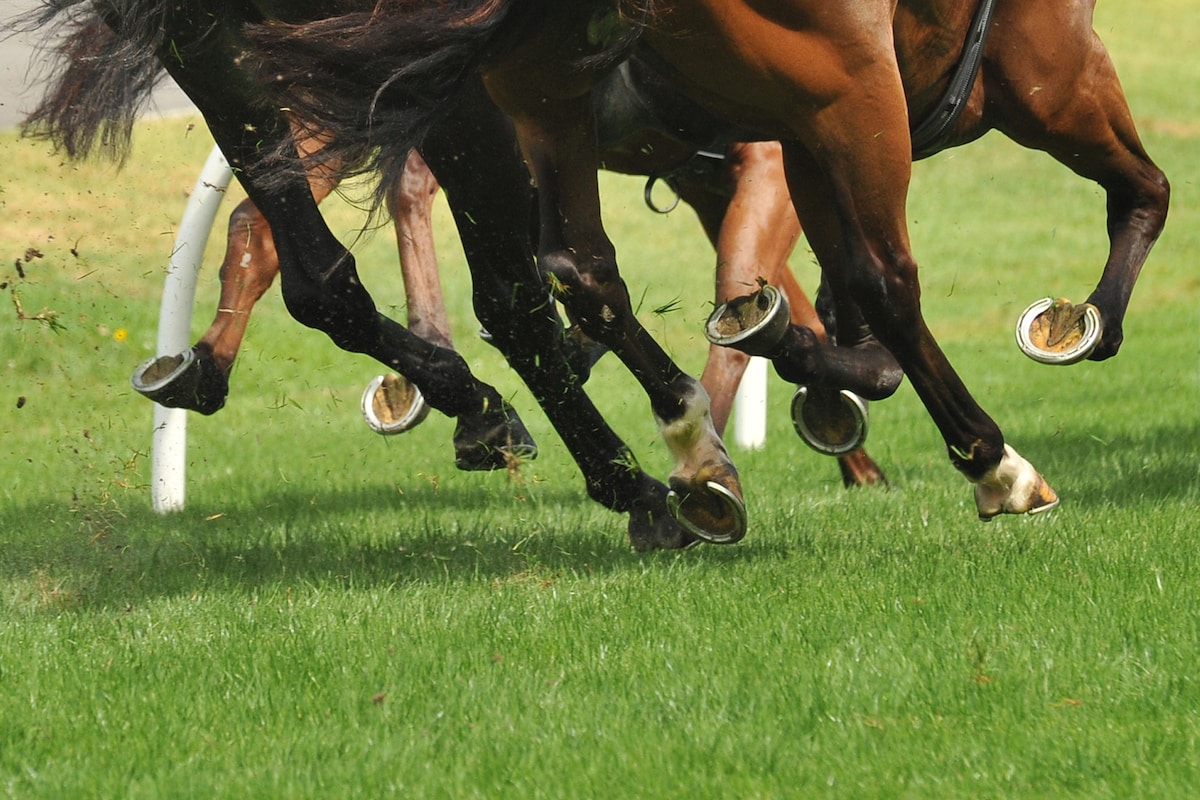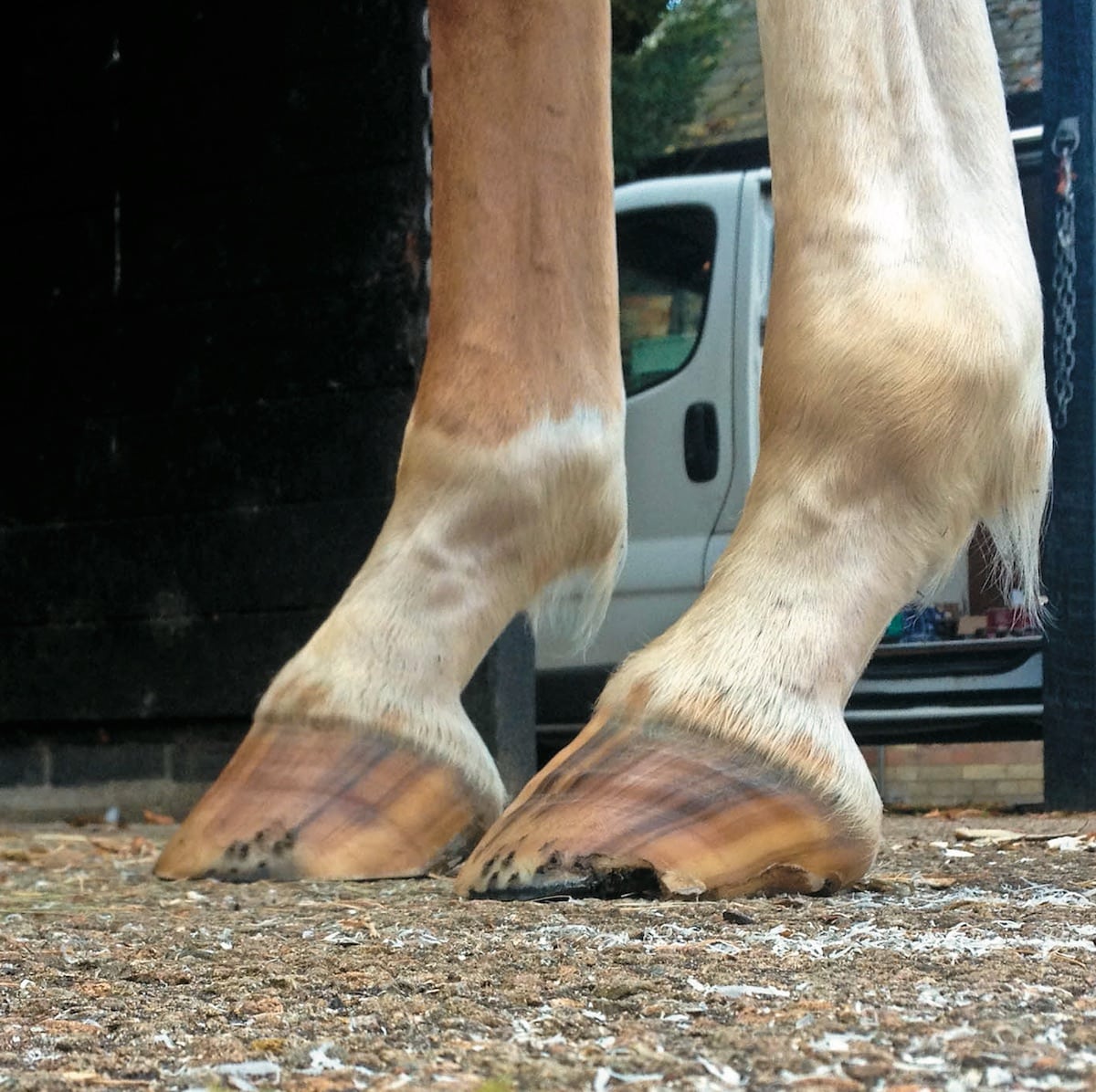Left unmanaged, this common condition in Thoroughbreds can cause bigger problems

The aluminum race plates Thoroughbreds wear on the track offer traction but not much support. Courtesy istock.com
Horses within a breed tend to share certain characteristics. Arabians have dished faces and arched necks, for example, and Quarter Horses have bulky muscles and often small feet. Bred and built for speed, Thoroughbreds are often leggy and lean. They also tend to have thin-soled, weak-walled hooves with a propensity toward long-toe, low-heel (LTLH) syndrome. But LTLH doesn’t have to be every OTTB’s destiny, says Scott Morrison, DVM, who frequently sees Thoroughbreds as a podiatrist at Rood & Riddle Equine Hospital in Lexington, Kentucky. He’s also developed specialty therapeutic horseshoes, and he lectures internationally on podiatry and farriery.
What Is “Long-Toe, Low-Heel” Syndrome?
As the term aptly describes, LTLH is simply a toe that’s longer than normal and ideal and a heel that’s lower than normal and ideal for the horse’s conformation. While the condition is most common in a horse’s front feet, it can occur in the hind feet, as well.
The combination of long toe and low heel results in a shallow hoof angle. That shallow angle leads to coffin (final bone at the bottom of the bony column of the leg, in the hoof capsule) and pastern bone misalignment and improperly redistributes pressure on the foot and leg. Specifically, it changes the hoof’s breakover (the point at which the heels leave the ground and start to rotate around the toe, which is still in contact with the ground) and creates leverage against the soft tissues along the back of the lower leg, most notably the deep digital flexor tendon (DDFT). The longer the toe, the more leverage placed against the back of the leg when the horse is in motion. More pressure on the DDFT — which runs from the knee down the back of the cannon bone, glides behind the navicular bone and attaches to the coffin bone — means more pressure on the fragile navicular bone and its associated structures.
Due to how the horse’s foot is loaded, leaving LTLH unmanaged can exacerbate the condition. Underrun or crushed heels can develop, a similar, related condition that leaves the heels collapsed and the foot’s palmar angle (that which the bottom of the coffin bone makes with the ground) reversed. This leads to a chicken-and-egg situation where the longer toe creates leverage that crushes the heels, and the crushed heels make for a longer toe. The result is pathology — disease or damage — in the heel bulbs, digital cushion and frog.
The long-term consequences of unmanaged LTLH include bruising, prolapsed frog (the frog and digital cushion have fallen below the hoof wall), caudal (rearward) heel pain, soft tissue tears (e.g., “bowed” tendons), pedal osteitis (inflammation of the coffin bone), osteoarthritis of the pastern (or what many refer to as the ankle), navicular bursitis (inflammation of the fluid-filled sac cushioning the navicular bone from the DDFT) or — more generally — navicular syndrome.

“LTLH” is simply a toe that’s longer than normal and ideal and a heel that’s lower than normal and ideal for the horse’s conformation. Courtesy Dr. Simon Curtis
Why Do Thoroughbreds Get LTLH?
Long toes and low heels happen in horses for a variety of reasons. In Thoroughbred racehorses, in particular, several of these reasons converge, says Morrison. They include:
Long pasterns. Today’s Thoroughbred is built for speed, and part of that build often includes long, shallow-angled pasterns. Hoof angle tends to follow pastern angle, so if the pastern is long and the angle is shallow, then the hoof will mirror that.
Weak hoof walls. “Thoroughbreds are thin-skinned, thin-soled and their feet change rapidly,” Morrison says. That ability to rapidly change means hoof capsule distortion can happen quickly, even within a single shoe cycle. But, he adds, that fortunately means the Thoroughbred hoof is also responsive to corrective trimming and farriery and can improve significantly in a short amount of time.
High-intensity, high-speed training. A healthy horse’s foot hits the ground in a heel-toe fashion, which means the heel is absorbing the initial force of impact. Of course, a gallop stride will have more impact than the walk or trot.
“Speed training puts pressure on the heels,” Morrison says. “There are two things working against them, because they’re hitting their heels really hard: Growth slows down, and the heel tubules fold over because of the repetition (of the hoof hitting the ground with each stride).”
Racing plates. Instead of traditional steel shoes, racehorses wear aluminum race plates. When comparing steel shoes to aluminum plates, think trail running shoes versus lightweight racing spikes for human athletes — the goals are different. In the case of aluminum, it’s about 2.5 times softer than steel and more malleable.
“Racing plates offer really good traction, but not a lot in the way of support,” Morrison says. That lack of shoe support can leave the hoof capsule vulnerable to stress from the previously mentioned high-intensity, high-speed workouts.
Living in a stall. A horse’s foot is dynamic and influenced by his environment. For example, a moist environment makes hooves soft, while a dry one makes them hard in some cases and brittle in others. Additionally, throughout the day, says Morrison, weight-bearing movement promotes blood circulation, which encourages hoof growth and delivers oxygen to the foot’s internal structures. As the horse moves through a paddock or pasture, dirt and manure pack the bottom of his feet (think of the debris like modeling clay), giving them arch support and reinforcing their concavity. That concavity, in turn, gives arch support, which helps the sole clear the ground, protecting it from bruising, and prevents frog prolapse. Now, consider that racehorses spend most of their days in clean, straw-bedded stalls. Standing in a stall means a Thoroughbred isn’t getting his foot naturally packed with debris, and he isn’t promoting circulation. The result is a less-than-healthy hoof, Morrison says.
With these factors in mind, you shouldn’t be surprised when prospect-shopping if many of the Thoroughbreds you see have LTLH. If a horse’s prepurchase veterinary exam goes well and he otherwise meets your needs, then LTLH isn’t necessarily a reason to pass on him, Morrison says.
You Bought an OTTB With LTLH. Now What?
Once you own your OTTB with LTLH, you’ll want to address his feet right away. The longer you wait, the harder it can be to correct the condition. Morrison makes the following recommendations:
Feed him right. You can’t have a healthy hoof without first having a healthy horse, and health is often tied to good nutrition. “Feed a well-balanced diet with biotin and fatty acids,” Morrison says. A combination of good-quality forage and a well-formulated concentrate feed containing proper amounts of essential trace minerals and vitamins is a better option than many highly marketed hoof supplements, he says, which can contain unverified amounts of ingredients backed by unsubstantiated claims. Work with your veterinarian or equine nutritionist to formulate the best diet for your OTTB.
Try barefoot. Thoroughbreds straight off the track often benefit from a “let down” period of six months to a year to transition from racing to civilian life. That time off work helps them decompress mentally, heal any injuries or recover from health issues and go from elite athlete to more of a, well, average horse.
Morrison has a suggestion for this letdown time: Let your OTTB go barefoot.
“A barefoot Thoroughbred?” you might be thinking. Yes, it can done, Morrison insists, as long as you can find an open-minded farrier and give your horse the support he needs during this transition period. A controlled, healthy living environment that’s sanitary (no muck and manure) with good footing (not rocky) is also critical for any horse moving from shoes to barefoot, he says. This will help prevent bruising and hoof wall breakage.
A good, balanced trim is also essential to the process, Morrison says, moving the breakover as far back toward the hoof’s center as possible and maintaining heel growth.
“I like to try to get the hoof back to as natural of a condition as possible,” he says.
Allowing the hoof to interface with the ground without the interference of a shoe will help promote circulation and growth, improving the health and shape of the foot, he adds.
However, considering many Thoroughbreds have tender feet, Morrison doesn’t necessarily suggest pulling shoes and letting the horse fend for himself. Instead, he suggests using therapeutic hoof boots to transition the foot and allow the sole to harden. A sole-hardening solution can help, as can packing materials designed to protect the sole. In some cases, if the horse needs more protection, Morrison will use a glue-on shoe as an intermediate step toward barefoot.
Get supportive shoes if necessary. Barefoot isn’t always an option, especially as you move your horse into work that might require more hoof and frog support. In these cases Morrison suggests “a good, balanced shoe that supports the frog, coffin bone and sole” without adding pressure that will further crush the heels. Morrison cites heart bar shoes, pads and/or hoof packing material as good examples.
Take-Home Message
The long-toe, low-heel condition can cause several serious soundness problems, ranging from osteoarthritis and soft tissue injuries to navicular syndrome. Many racing Thoroughbreds are predisposed to the condition due to their genetics, conformation, management and how they exercise. But that doesn’t mean you should pass on a Thoroughbred freshly off the track just because he has LTLH. In fact, many horses improve with judicious foot care and management.
This article was originally published in the Winter 2020 issue of Off-Track Thoroughbred Magazine, the only publication dedicated to the Thoroughbred ex-racehorse in second careers. Want four information-packed issues a year delivered to your door or your favorite digital device? Subscribe now!

